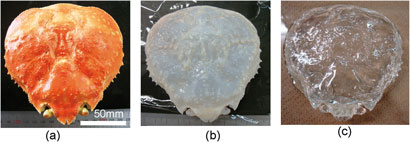Researchers in Japan have made a crab shell transparent. Then, using knowledge gained from this activity, they created a transparent nanocomposite sheet, incorporating powdered chitin from crab shells. The nanocomposite could have applications in devices that need a high light transmittance, such as flat panel displays.
Scientists have previously used cellulose from plants and chitin to strengthen materials, giving biologically-inspired nanocomposites. If natural nanofibres are dispersed widely enough in a transparent polymer matrix, they can strengthen the polymer and the resulting nanocomposite material will retain its transparency. Work on optically transparent polymers containing cellulose nanofibres shows they have a low axial thermal expansion coefficient, meaning their size does not vary with temperature, making them ideal for use in flexible flat panel displays and solar cells. Interested to know more? Read the full article in Chemistry World here…

Preparing the transparent crab shell: (a) original shell, (b) shell after removal of matrix substances and (c) transparent crab shell after immersion in acrylic resin
The transparent crab: preparation and nanostructural implications for bioinspired optically transparent nanocomposites
M I Shams, M Nogi, L A Berglund and H Yano
Soft Matter, 2012, Advance Article
DOI: 10.1039/c1sm06785k
To keep up-to-date with all the latest research, sign up for the Soft Matter e-Alert or RSS feeds or follow Soft Matter on Twitter or Facebook










